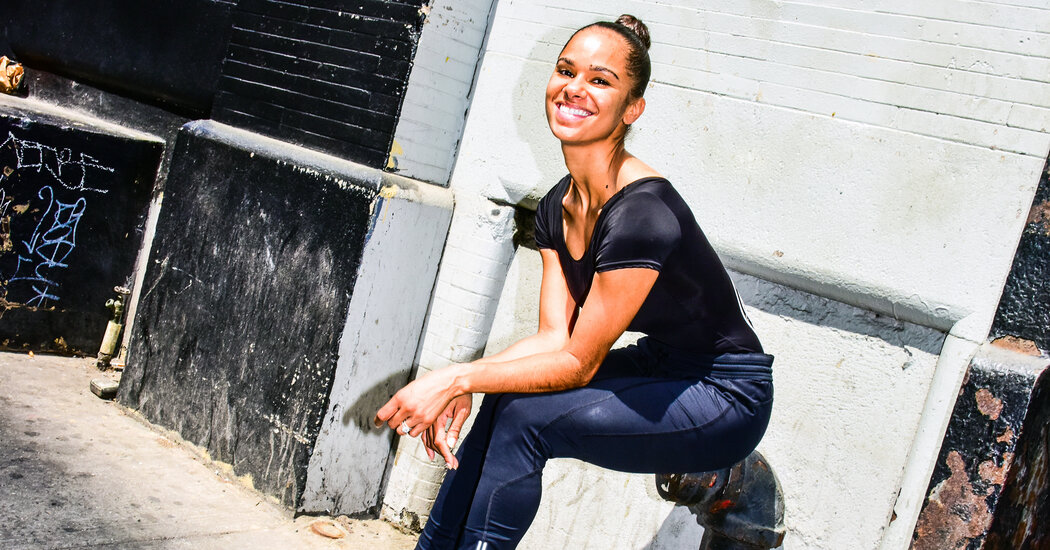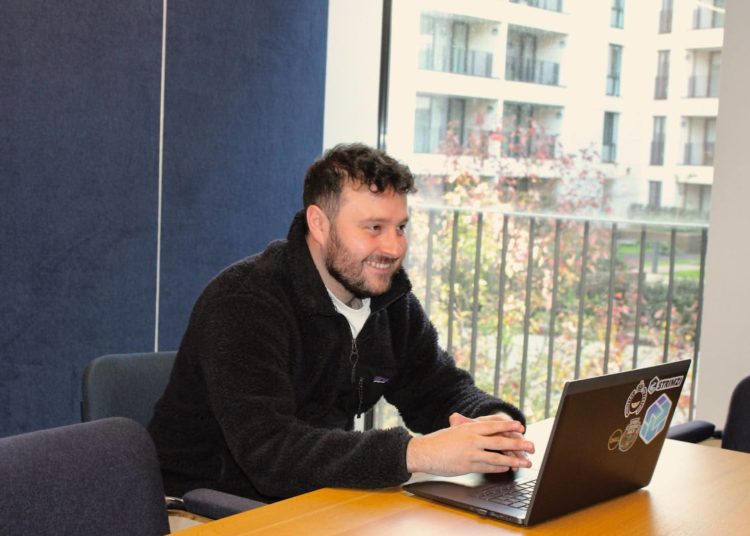Misty Copeland never wanted a farewell performance. In the weeks leading up to her last appearance with American Ballet Theater, she came to a realization: Bows are not her thing.
“I’ve always been like, we did it!” she said in an interview. “Now let’s move on.”
But as the most famous dancer in the world except for, say, Mikhail Baryshnikov, choosing to close her Ballet Theater chapter discreetly wasn’t quite right either.
As Ballet Theater’s first Black female principal dancer, Copeland made history not only as an artist, but also as a leader and a role model She’s handled it all with authority and humor, humility and grace.
In the end, Copeland gave her farewell performance last week at the prodding of two mentors, Susan Fales-Hill and Darren Walker, who stepped in and, as Copeland put it, “were like, ‘Girl, it’s happening now or never.’”
She appeared in the balcony scene from “Romeo and Juliet”; a new work by Kyle Abraham; and selections from Twyla Tharp’s “Sinatra Suite.” In all, she danced with joy and abandon, with radiant flow and sweep. Copeland, mature and confident, even seemed taller.
But she didn’t feel how she looked. Days before the show, she found herself dealing with a hip injury. Copeland hadn’t danced for five years. Just before the pandemic, she had pulled out of “Giselle” with an injury; in 2022, she had a baby with her husband, Olu Evans. But she remained busy, running her foundation and a production company with Leyla Fayyaz.
Copeland danced through the pain at her farewell performance, a Ballet Theater gala that emphasized her achievements with two short films. Copeland, who came to dance late, had an unstable childhood. Ballet was her anchor. In one of the films, Tharp, whom Copeland considers a mentor, said, “There was a righteousness about her.”
At Ballet Theater, that righteousness will live on. During a series of speeches, it was announced that Copeland was unanimously approved to join Ballet Theater’s board of trustees. One of her biggest aims is to have more teachers of color in the company’s school. “I wouldn’t be doing this still,” she said, “if I didn’t feel hopeful and know that we could do it.”
Two days after confetti rained down on Copeland, she spoke about her career at Ballet Theater and what comes next. Here are edited excerpts from that conversation.
I loved your farewell performance. Did you feel free?
It’s hard to answer that. In so many ways, yes. Once you’re in shape and you’ve really focused on the artistry and the people and the relationships, it’s like, “Ah, this is what it is. This is what I forgot about; this is what it’s all for.” And then I’ve been dealing with a really severe hip injury.
What happened?
A week before the show, everything just kind of plummeted. It was really hard to dance with the complete abandon that I’m used to. By the time we got to “Sinatra,” I was in so much pain. I was changing things in the moment. But I was just trying to stay really connected to my partners and just really be present in that way. So I guess in my approach, I was free.
How do you feel now?
Yesterday, I physically couldn’t walk. My hip, it really locked up. It just needs to calm down. It’s really inflamed. I am actually on the way to the airport because I’m dancing in Los Angeles.
What?
It’s just ridiculous. I know, I know, I know! It’s a really cool opportunity. It’s nothing like what I did. As soon as I get back I’m meeting with my team of doctors and figuring out how I can continue. I want to find a way of doing things that I enjoy and that don’t include “Swan Lake.”
Can you tell me about that commitment to get back in shape?
I didn’t go straight to the barre. I started out with my personal trainer that I’ve been working with on and off for many years. A recommendation of Ms. Twyla Tharp. My biggest concern was getting injured. Craig Salstein was one of the first people that I called. He’s always been so great with working with injured dancers and people coming back. That’s what I needed. No judgment.
I had physical therapy throughout this whole process, and Pilates. I had a cortisone shot at the top of the year. I’ve been doing the steroid treatment and anti-inflammatories. My whole team, initially, when I met with them were like, “I don’t think you should do this.” And I was like, “Well, it’s happening, so help me get there.”
Did Twyla weigh in on your hip injury?
She was one of the first people that I called. Two days before the show I woke up to all these emails from her saying, “Call me, call, me.” She just said: “Misty, do whatever you want. I don’t care. Change the steps.” She’s like: “This isn’t about me. This isn’t about the choreography. Try to enjoy yourself.”
How was returning to the company different from you thought it might be?
You know those weird dreams where you’re back in high school and you’re like, “But wait, I don’t know any of you. I graduated. Why am I here?” So it was a bit overwhelming, but it was so interesting. The memories that came up were of when I first joined. I’m so happy that I did it. It was something that I didn’t know I needed.
How so?
I think to be able to understand the importance of the work in the studio — how meaningful it is, to me, beyond performing. It’s not just working on technical things or artistic choices. It’s like life, and it’s like therapy, and it is all so connected. We’re human beings experiencing this art form, so it’s not like we are completely separating all these things.
How did your relationship to movement change during the pandemic?
At the end of 2019, I was really struggling with trying to understand, “Why am I still doing this? What am I getting out of it? Am I using my voice and my platform and my reach in the best way that I can by still doing this? And do I still feel passionate about this?” Once the pandemic hit, I felt really relieved to stop moving my body. And I think it was one of the worst decisions I’ve ever made.
How do you feel now?
Now that I’ve gotten myself back into shape, I realized I have to keep moving my body. And I want to keep moving my body, but it can look like whatever I want it to look like. And I think that’s the beauty of movement and the beauty of aging and finding ways to move.
Do you see a pipeline for female Black dancers at Ballet Theater?
There’s so much opportunity. It’s really just about keeping them on track and supported. I was so fortunate to have the support that I had. And I also know that it was my willingness to accept it as well. That’s a huge part of this. I’ve tried many times with so many dancers, no matter what color they are, and not everyone is ready for it. Not everyone wants it. And so it’s not just about having the access to it.
Madison Brown [a corps de ballet member] is an unbelievable talent. And I’ve let her know I am here. I am in your corner with everything you need. And I don’t think that we’re at a lack of talent. I think it’s really just about support and consistency with the pipeline that’s in the school.
When you were growing up your nickname was Mouse, and you were shy. How did you find your voice?
It seems silly, but I had such a connection to music. A lot of that came out through Mariah Carey’s music. It was really finding my voice through other people’s lyrics and feeling a sense of confidence in my feelings. Even beyond just verbally being able to say things, I didn’t trust my own instincts and thoughts. That has a lot to do with my upbringing and the circumstances I was in.
How do you want to keep dancing?
I don’t know if I’ve figured that out. I would love to produce shows and do something kind of on my own terms and bringing an artist that I want to collaborate with. I’m also very open to Broadway. I want it to stay connected to dance. I’m not just trying to be out there to be out there at all.
How do you want to show people how ballet can be a force of good in the world?
I see it as such a bigger, fuller tool for humanity and community. My husband and I talk about where I came from and about the girl that I was before dance, and what it gave me. It’s so much more than maybe what people see. I was so underdeveloped as a kid. I was introduced to a discipline with structure, with consistency, with beauty, with calm, with music. Every human being should be experiencing this and not with the sole purpose in mind to make it a career. My goal with my foundation is that this is bigger than ballet and how important arts education and dance education is to our society. People are like, “But this isn’t for us, the Black community.” But it can be, and it is.
Gia Kourlas is the dance critic for The Times. She writes reviews, essays and feature articles and works on a range of stories.
The post Misty Copeland, Ballerina of the People, Moves On appeared first on New York Times.




